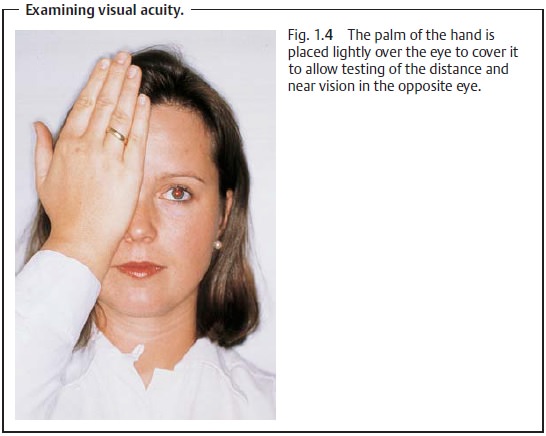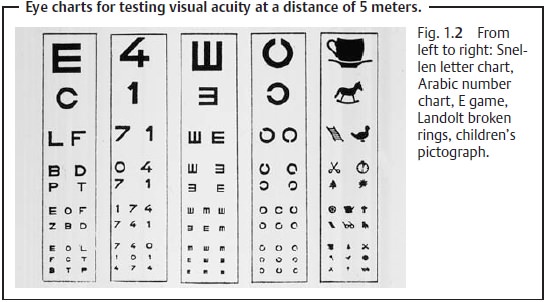Chapter: Ophthalmology: The Ophthalmic Examination
Ophthalmic Examination: Visual Acuity

Visual Acuity
Visual acuity, the sharpness of near and
distance vision, is tested separately for each eye. One eye is covered with a
piece of paper or the palm of the hand placed lightly over the eye. The fingers
should not be used to cover the eye because the patient will be able to see between
them (Fig. 1.4).

The general practitioner or student can perform an approximate test ofvisual
acuity. The patient is
first asked to identify certain visual symbolsreferred to as optotypes (see
Fig. 1.2) at a distance of 5 meters
or 20 feet (test ofdistance vision).
These visual symbols are designed so that optotypes of a cer-tain size can
barely be resolved by the normal eye at a specified distance (this standard
distance is specified in meters next to the respective symbol). The eye charts
must be clean and well illuminated for the examination. The sharpness of vision
measured is expressed as a fraction:
Normal visual acuity is 5/5 (20/20), or 1.0 as a decimal number, where theactual
distance equals the standard distance.

An example of diminished visual acuity (see Fig. 1.2): The patient sees only the “4” and none of
the smaller symbols on the left eye chart at a distance of 5 meters (20 feet)
(actual distance). A normal-sighted person would be able to discern the “4” at
a distance of 50 meters or 200 feet (standard distance). Accordingly, the
patient has a visual acuity of 5/50 (20/200) or 0.1.
The ophthalmologist tests visual acuity after determining
objective refraction using the integral lens system of a Phoroptor, or a box of
individual lenses and an image projector that projects the visual symbols at a
defined distance in front of the eye. Visual acuity is automatically calculated
from the fixed actual distance and is displayed as a decimal value. Plus lenses (convex lenses) are used for
farsightedness (hyperopia or
hypermetropia), minuslenses (concave
lenses) for nearsightedness (myopia),
and cylindrical lenses for astigmatism.
If the patient cannot discern the symbols on
the eye chart at a distance of 5 meters (20 feet), the examiner shows the
patient the chart at a distance of 1 meter or 3 feet (both the ophthalmologist
and the general practitioner use eye charts for this examination). If the
patient is still unable to discern any symbols, the examiner has the patient
count fingers, discern the direction of hand motion, and discern the direction
of a point light source.
Related Topics